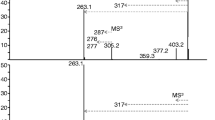Abstract
Purpose. Indomethacin is well known to be metabolized via O-demethylation and N-deacylation. In this paper we found an enzyme involved in the hydrolysis of amide-linkage of indomethacin and partially characterized it as well as its substrate specificity.
Methods. An indomethacin hydrolyzing enzyme was purified to homogeneity from pig liver microsomes using columns of Q-Sepharose, Red-Sepharose and Blue-Sepharose. The enzyme activity was assayed by measuring of ρ-chlorobenzoic acid liberated from indomethacin by HPLC.
Results. The purified enzyme effectively hydrolyzed the amide linkage in indomethacin but not those in α-naphthylacetate and ρ-nitrophenylacetate, which are typical substrates for carboxylesterase. The subunit molecular mass of the enzyme was 65 kDa according SDS-polyacrylamide gel electrophoresis. The Michaelis constant (Km) and maximum velocity (Vmax) values for indomethacin were 67.8 µM and 9.02 nmol/min/mg protein, respectively. The amino acid sequence analysis of the enzyme after cyanogen bromide cleavage showed high homology with a mouse carboxylesterase isozyme designated as ES-male. The activity of indomethacin hydrolysis was relatively high in the pig, rabbit and human liver homogenate, but not in those from rat and mouse. On the other hand, purified human liver carboxylesterases pl 5.3 and 4.5, and pig liver carboxylesterases have no catalytic activity for indomethacin.
Conclusions. These results indicate that the hydrolysis of amide-linkage of indomethacin in humans would be associated with an enzyme similar to the indomethacin hydrolyzing enzyme from pig liver microsomes described here.
Similar content being viewed by others
REFERENCES
M. A. Heymann, A. M. Rudolph, and N. H. Silverman. Closure of the ductus arteriosus in premature infants by inhibition of prostaglandin synthesis. N. Engl. J. Med. 295:530–533 (1976).
N. Futaki, S. Takahashi, M. Yokoyama, I. Arai, S. Higuchi, and S. Otomo. NS-398, a new anti-inflammatory agent, selectively inhibits prostaglandin G/H synthase/cyclooxygenase (COX-2) activity in vitro. Prostaglandins 47:55–59 (1994).
M. Clozel, K. Beharry, and J. V. Aranda. Indomethacin metabolism in liver microsomes during postnatal development in the rat. Biol. Neonate 50:83–90 (1986).
M. A. Evans, C. Papazafiratou, R. Bhat, and D. Vidyasagar. Indomethacin metabolism in isolated neonatal and fetal rabbit hepatocytes. Pediatr. Res. 15:1406–1410 (1981).
R. E. Harman, M. A. P. Meisinger, G. E. Davis, and F. A. Kuehl, Jr. The metabolites of indomethacin, a new anti-inflammatory drug. J. Pharmacol. Exp. Ther. 143:215–220 (1964).
D. E. Duggan, A. F. Hogans, K. C. Kwan, and F. G. McMahon. The metabolism of indomethacin in man. J. Pharmacol. Exp. Ther. 181:563–575 (1972).
M. Sugiura, Y. Iiizumi, T. Adachi, Y. Ito, K. Hirano, and S. Sawaki. Studies on human urinary and renal esterases that migrate to the γ-globulin region upon cellulose acetate electrophoresis. Chem. Pharm. Bull. 29:2920–2927 (1981).
K. Krisch. Reaction of a microsomal esterase from hog-liver with diethyl ρ-nitrophenyl phosphate. Biochim. Biophys. Acta. 122:265–280 (1966).
U. K. Laemmli. Cleavage of structural proteins during the assembly of the head of bacteriophage T4. Nature 227:680–685 (1970).
M. Matsushima, H. Inoue, M. Ichinose, S. Tsukada, K. Miki, K. Kurokawa, T. Takahashi, K. Takahashi. The nucleotide and deduced amino acid sequences of porcine liver proline-β-naphty-lamidase. FEBS Lett. 293:37–41 (1991).
K. Aida, R. Moore, and M. Negishi. Cloning and nucleotide sequence of a novel, male-predominant carboxylesterase in mouse liver. Biochim. Biophys. Acta. 1174:72–74 (1993).
M. Hosokawa, T. Maki, and T. Satoh. Characterization of molecular species of liver microsomal carboxylesterases of several animal species and humans. Arch. Biochem. Biophys. 277:219–227 (1990).
M. Mishima, S. Kobayashi, R. Hashida, T. Yuzuriha, T. Sato, and T. Satoh. Enzymic hydrolysis of indomethacin famesil, a prodrug of indomethacin, by carboxylesterase in cultured synovial cells. Res. Commun. Chem. Pathol. Pharmacol. 72:183–190 (1991).
I. L. Natoff, J. S. Nixon, R. J. Francis, L. R. Klevans, M. Brewster, J. Budd, A. T. Patel, J. Wenger, and E. Worth. Biological properties of the angiotensin-converting enzyme inhibitor cilazapril. J. Cardiovasc. Pharmacol. 7:569–580 (1985).
P. E. O. Williams, A. N. Brown, S. Rajaguru, R. J. Francis, G. E. Walters, J. McEwen, and C. Dumin. The pharmacokinetics and bioavailability of cilazapril in normal man. Brit. J. Clin. Pharmacol. 27:181S–188S (1989).
Author information
Authors and Affiliations
Rights and permissions
About this article
Cite this article
Terashima, K., Takai, S., Usami, Y. et al. Purification and Partial Characterization of an Indomethacin Hydrolyzing Enzyme from Pig Liver. Pharm Res 13, 1327–1330 (1996). https://doi.org/10.1023/A:1016061614399
Issue Date:
DOI: https://doi.org/10.1023/A:1016061614399




